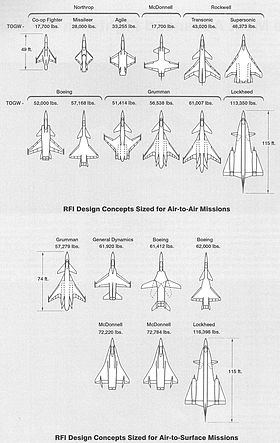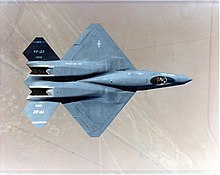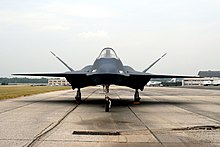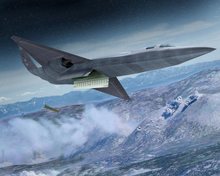
The Lockheed Martin/Boeing F-22 Raptor is an American twin-engine all-weather stealth fighter aircraft developed and produced for the United States Air Force (USAF). As a product of the USAF's Advanced Tactical Fighter (ATF) program the aircraft was designed as an air superiority fighter, but also incorporates ground attack, electronic warfare, and signals intelligence capabilities. The prime contractor, Lockheed Martin, built most of the F-22's airframe and weapons systems and conducted final assembly, while program partner Boeing provided the wings, aft fuselage, avionics integration, and training systems.
F-19 is a skipped DoD designation in the Tri-Service fighter aircraft designation sequence which was thought by many popular media outlets to have been allocated to the Lockheed F-117 Nighthawk, but was actually skipped in favor of F-20 for the Northrop F-5G Tigershark at Northrop's request to avoid confusion with the MiG-19.

The McDonnell XF-85 Goblin is an American prototype fighter aircraft conceived during World War II by McDonnell Aircraft. It was intended to deploy from the bomb bay of the Convair B-36 bomber as a parasite fighter. The XF-85's intended role was to defend bombers from hostile interceptor aircraft, a need demonstrated during World War II. McDonnell built two prototypes before the Air Force (USAF) terminated the program.
Supercruise is sustained supersonic flight of a supersonic aircraft without using afterburner. Many supersonic military aircraft are not capable of supercruise and can maintain Mach 1+ flight only in short bursts with afterburners. Aircraft such as the SR-71 Blackbird are designed to cruise at supersonic speed with afterburners enabled.

The fourth-generation fighter is a class of jet fighters in service from around 1980 to the present, and represents design concepts of the 1970s. Fourth-generation designs are heavily influenced by lessons learned from the previous generation of combat aircraft. Third-generation fighters were often designed primarily as interceptors, being built around speed and air-to-air missiles. While exceptionally fast in a straight line, many third-generation fighters severely lacked in maneuverability, as doctrine held that traditional dogfighting would be impossible at supersonic speeds. In practice, air-to-air missiles of the time, despite being responsible for the vast majority of air-to-air victories, were relatively unreliable, and combat would quickly become subsonic and close-range. This would leave third-generation fighters vulnerable and ill-equipped, renewing an interest in manoeuvrability for the fourth generation of fighters. Meanwhile, the growing costs of military aircraft in general and the demonstrated success of aircraft such as the McDonnell Douglas F-4 Phantom II gave rise to the popularity of multirole combat aircraft in parallel with the advances marking the so-called fourth generation.
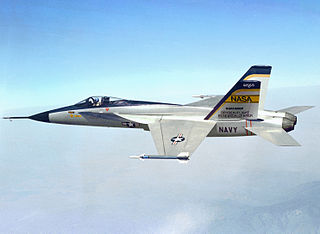
The Northrop YF-17 was a prototype lightweight fighter aircraft designed by Northrop aviation for the United States Air Force's Lightweight Fighter (LWF) technology evaluation program. The LWF was initiated because many in the fighter community believed that aircraft like the F-15 Eagle were too large and expensive for many combat roles. The YF-17 was the culmination of a long line of Northrop designs, beginning with the N-102 Fang in 1956, continuing through the F-5 family.
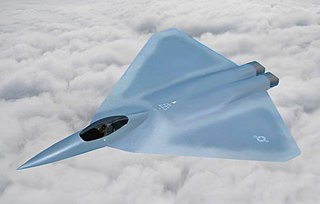
The Lockheed Martin X-44 MANTA was an American conceptual aircraft design by Lockheed Martin that has been studied by NASA and the U.S. Air Force. It was intended to test the feasibility of full yaw, pitch and roll authority without tailplanes. Attitude control relies purely on 3D thrust vectoring. The aircraft design was derived from the F-22 Raptor and featured a stretched delta wing without tail surfaces.

The Advanced Tactical Fighter (ATF) was a program undertaken by the United States Air Force to develop a next-generation air superiority fighter to counter emerging worldwide threats, including Soviet Sukhoi Su-27 and Mikoyan MiG-29 fighters under development in the 1980s, Beriev A-50 airborne warning and control system (AWACS), and increasingly sophisticated surface-to-air missile systems. Lockheed and Northrop were selected in 1986 to respectively develop the YF-22 and the YF-23 technology demonstrator aircraft for the program's demonstration and validation (Dem/Val) phase. These aircraft were evaluated in 1991 and the Lockheed team was selected for full-scale development, or engineering and manufacturing development (EMD), and later developed the F-22 Raptor for production and operational service.

The Pratt & Whitney F119, company designation PW5000, is an afterburning turbofan engine developed by Pratt & Whitney for the Advanced Tactical Fighter (ATF) program, which resulted in the Lockheed Martin F-22 Raptor. The engine delivers thrust in the 35,000 lbf (156 kN) class and was designed for sustained supersonic flight without afterburners, or supercruise. Delivering almost 22% more thrust with 40% fewer parts than its F100 predecessor, the F119 allows the F-22 to achieve supercruise speeds of up to Mach 1.8. The F119's nozzles incorporate thrust vectoring that enable them to direct the engine thrust ±20° in the pitch axis to give the F-22 enhanced maneuverability.

The Lockheed/Boeing/General Dynamics YF-22 is an American single-seat, twin-engine fighter aircraft technology demonstrator designed for the United States Air Force (USAF). The design team was a finalist in the USAF's Advanced Tactical Fighter (ATF) competition, and two prototypes were built for the demonstration/validation phase of the competition. The YF-22 team won the contest against the YF-23 team for full-scale development, and the design was developed into the Lockheed Martin F-22. The YF-22 has a similar aerodynamic layout and configuration as the F-22, but with notable differences in the overall shaping such as the position and design of the cockpit, tail fins and wings, and in internal structural layout.

The Lockheed Martin/Boeing FB-22 was a proposed stealth bomber aircraft marketed to the United States Air Force. Its design was derived from the F-22 Raptor. Lockheed Martin proposed its unsolicited design as a "regional bomber" to complement the aging U.S. strategic bomber fleet. Lockheed Martin appeared to suspend work on the concept following the 2006 Quadrennial Defense Review, which called for a new and much larger strategic Next-Generation Bomber by 2018.

The Mikoyan Project 1.44/1.42 is a multirole fighter technology demonstrator developed by the Mikoyan design bureau. It was designed for the Soviet Union's MFI project for the I-90 program, the answer to the U.S.'s Advanced Tactical Fighter (ATF). The MFI was to incorporate many fifth-generation jet fighter features such as supermaneuverability, supercruise, and advanced avionics, as well as some degree of radar signature reduction.
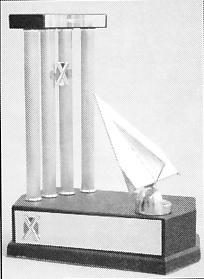
The Iven C. Kincheloe Award recognizes outstanding professional accomplishment in the conduct of flight testing. It was established in 1958 by the Society of Experimental Test Pilots in memory of test pilot and Korean War ace Iven C. Kincheloe, United States Air Force, who died during flight testing.

Lockheed Have Blue was the code name for Lockheed's proof of concept demonstrator for a stealth fighter. Have Blue was designed by Lockheed's Skunk Works division, and tested at Groom Lake, Nevada. The Have Blue was the first fixed-wing aircraft whose external shape was defined by radar engineering rather than by aerospace engineering. The aircraft's faceted shape was designed to deflect electromagnetic waves in directions other than that of the originating radar emitter, greatly reducing its radar cross-section.

A supersonic aircraft is an aircraft capable of supersonic flight, that is, flying faster than the speed of sound. Supersonic aircraft were developed in the second half of the twentieth century. Supersonic aircraft have been used for research and military purposes, but only two supersonic aircraft, the Tupolev Tu-144 and the Concorde, ever entered service for civil use as airliners. Fighter jets are the most common example of supersonic aircraft.

The Lightweight Fighter (LWF) program was a United States Air Force technology evaluation program initiated in the late 1960s by a group of officers and defense analysts known as the "Fighter Mafia". It was spurred by then-Major John Boyd's 'energy-maneuverability' (E-M) theory, which indicated that excessive weight would have severely debilitating consequences on the maneuverability of an aircraft. Boyd's design called for a light-weight fighter with a high thrust-to-weight ratio, high maneuverability, and a gross weight of less than 20,000 lb (9,100 kg), half that of its counterpart, the McDonnell Douglas F-15 Eagle. It resulted in the development of the General Dynamics YF-16 and Northrop YF-17. Late in the program, in 1974, with the promise of European sales, the Air Force changed the program name to Air Combat Fighter (ACF), and committed to purchasing 650 models of the YF-16, adopted as the F-16 Fighting Falcon. The U.S. Navy adopted a modified version of the YF-17 as the McDonnell Douglas F/A-18 Hornet.

The General Electric YF120, internally designated as GE37, was a variable cycle afterburning turbofan engine designed by General Electric Aircraft Engines in the late 1980s and early 1990s for the United States Air Force's Advanced Tactical Fighter (ATF) program. It was designed to produce maximum thrust in the 35,000 lbf (156 kN) class. Prototype engines were installed in the two competing technology demonstrator aircraft, the Lockheed YF-22 and Northrop YF-23.

The Teen Series is a popular name for a group of American combat aircraft. The name stems from a series of American supersonic jet fighters built for the United States Air Force and the United States Navy during the late 20th century. The designations system was the 1962 United States Tri-Service aircraft designation system, which reset the F-# sequence. The term typically includes the Grumman F-14 Tomcat, McDonnell Douglas F-15 Eagle, General Dynamics F-16 Fighting Falcon, and McDonnell Douglas F/A-18 Hornet.

A fifth-generation fighter is a jet fighter aircraft classification which includes major technologies developed during the first part of the 21st century. As of 2024, these are the most advanced fighters in operation. The characteristics of a fifth-generation fighter are not universally agreed upon, and not every fifth-generation type necessarily has them all; however, they typically include stealth, low-probability-of-intercept radar (LPIR), agile airframes with supercruise performance, advanced avionics features, and highly integrated computer systems capable of networking with other elements within the battlespace for situational awareness and C3 (command, control and communications) capabilities.
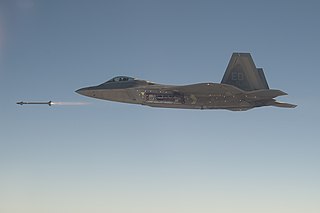
The 411th Flight Test Squadron is a United States Air Force squadron assigned to the 412th Operations Group of Air Force Materiel Command, stationed at Edwards Air Force Base, California. It conducted the Advanced Tactical Fighter program flyoff competition between the Lockheed YF-22 and Northrop YF-23 prototypes. Following the completion of the competition, the squadron has conducted testing of the Lockheed Martin F-22.

